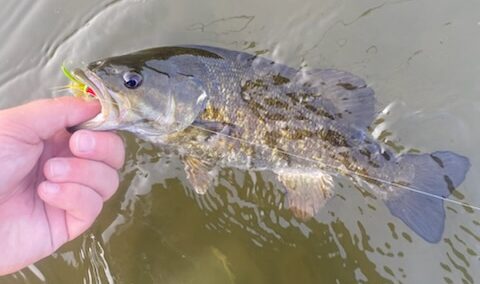Chasing Bronzebacks: Fly Fishing for Smallmouth Bass

Fly fishing has long been synonymous with chasing trout. However, as spring turns to summer the best hatches are behind us and water temperatures are on the rise every day. Being cold water fish, trout are easily stressed in the warmer water temperatures. Given this fact, trout anglers are advised to use caution when water temperatures reach about 65 degrees.
However, the increased temperatures are no reason to put away your fishing gear. Warm water fish offer many great opportunities for fly fishermen. Perhaps king among these angling options is the smallmouth bass.
Smallmouth bass can be found in many lakes, rivers, and streams throughout the Mid-Atlantic states and offer an exciting challenge for the fly rod angler. In fact, chasing smallmouth in rivers and streams is my favorite fly fishing pursuits year in and year out.
Why Smallmouth on the Fly?

Growing up, the smallmouth bass always reigned supreme among my angling opportunities. The Juniata River, which flows through my hometown, offers phenomenal smallmouth fishing, and this is where I cut my teeth learning to fish. The Juniata is my favorite place to fish and so naturally when I took up fly fishing I went there often. A few outings were all it took to make the smallmouth bass my favorite fly rod target.
Smallmouth are very aggressive predators by nature. This leads to some exciting angling action when conditions are right. Also, once hooked, the smallmouth put up a great fight. Many consider them to be among the best fighting fish in freshwater.
Equipment
You can get started fishing for smallmouth with almost any standard trout fly rod. While some anglers prefer a 6, 7, or 8 weight to throw bigger, more wind resistant smallmouth flies, it is not a necessity. Currently, the 9’ 5 weight is a very popular all-around trout rod and is more than adequate for catching smallmouth bass.
As far as lines go, the majority of the time I use a weight forward, floating fly line. This is a great set up for a variety of conditions, and can be used for any flies fished. Although not essential, a sinking tip line can be beneficial to get the fly closer to the bottom depending on the conditions. Early spring when the water is often running higher and colder, I may consider using a sinking tip, but the majority of the year I stick with floating line.
Given their aggressive nature, smallmouth bass are not leader shy. Most of the time I fish a 6-8 foot leader that tapers down to 2x or 3x tippet. Leader length can be adjusted based on conditions. For example, if using floating line and fishing a subsurface pattern, the longer the leader the deeper you will be able to get your fly. If you are fishing a sinking tip line, a longer leader will not be needed, and can in fact make casting the sinking tip line more difficult.
Best Flies for Smallmouth Bass
One of the great attributes of smallmouth bass is their aggressive, predatory nature. When they are hunting for food, smallmouth are not finicky. This means a simple fly selection is all that’s needed to find success.
My favorite subsurface flies include Clouser deep minnow streamers and a simple crayfish imitation I developed and call Marter’s crayfish. The majority of smallmouth bass I catch each year come on one of those two flies.
When the water flows are clear, a color combination of olive and brown/tan works great for both the Clouser minnow and Marter’s crayfish. If fishing murky water, switching to a Clouser minnow in chartreuse over yellow or yellow and red can increase chances the fish will find and take your fly.
While these are my favorite flies, other streamer and crayfish patterns can certainly be effective too. Regardless of the specific pattern, I highly recommend flies in color combinations of olive and brown/tan. Over the years, I have tried many different color combinations and this one outperforms the others the majority of the time.
During all times of the year, smallies can be caught using these subsurface patterns. Just change depth and retrieval speed to match the mood of the fish and you’ll be in business. Each outing finding the right combination of fly depth and retrieval speed may take some trial and error. However, as a general rule, colder water often requires a low and slow retrieval. Faster retrieves higher in the water column become more effective once water temperatures rise.
As water temperature increases in the late spring/summer into early fall, many anglers love chasing the top water bite for smallmouth bass. As with a streamer presentation, top water fly selection does not need to be extensive. Keeping it simple with some basic poppers and a diving type top water like a Dahlberg diver will deliver plenty of exhilarating strikes.
To pursue smallmouth bass on top, tie on your top water pattern and cast it upstream at about a 45-degree angle. As the fly floats down with the current strip it in to cause disturbance to the water surface. Continue this action to the end of the drift or until the fly is fully retrieved.
As with streamers, top water retrieval speed needs to be varied depending on conditions. In addition, the amount of action/water disturbance caused by the top water fly is another variable to account for. I always start with minimal action and long pauses between strips. Each subsequent cast I increase levels of each until I start getting takes. Starting out too aggressively can spook fish under some scenarios, particularly when the water is low and clear.
Generally speaking, water clarity as well as surface calmness will be a good indicator of the fly retrieval needed. Clear, calm water often means minimal surface disturbance will be necessary. An example of such a scenario would be fishing a slow-moving pool under low, clear conditions. As clarity decreases and/or surface turbulence increases, retrieves that invoke more water disturbance may be more effective at triggering strikes. Examples of these instances would be in murkier, higher flows after a rain event or in faster moving riffles.
Smallmouth are warm water fish and as such are most active when water temperatures are above 60 degrees. However, fish can be found actively feeding once temperatures reach the 50-degree mark. This usually coincides with early spring in the Mid-Atlantic states. I watch local water temperatures and will begin targeting smallies once waters reach 50 degrees. Good fishing opportunities pick up when temperature gets closer to and exceeds 55 degrees. Typically, this happens around mid- to late-April. This time of year, is referred to as the pre-spawn in bass fishing circles.
Pre-Spawn
Fishing for smallmouth during this time of year can be slow but it is also a great time to catch large fish. Fish activity is just beginning to pick up again after a sluggish winter. Often larger fish, who need more food, will be feeding more actively than their smaller counterparts. Pre-spawn fishing trips do not often produce large quantities of fish, but the quality/size of those hooked are likely to be better than average. Fish activity continues to increase as water temperatures rise. This will continue until fish begin spawning in the later spring/early summer.
Spawn
The spawn is evident once smallmouth bass can be actively observed on beds. When this occurs, I recommend refraining from fishing as spawning fish experience a good deal of stress. Not all smallmouth spawn at the same time though so you do not need to completely stop fishing. Just find locations where spawning is not occurring yet and good pre-spawn fishing can often be found.
Post-Spawn
Following the spawn, there is often a brief window of low fish activity. This lull in the action occurs as the smallmouth rest and recover from the stressors of the spawning period. This is often brief and followed by good fishing opportunities throughout the summer months. As stated earlier, smallmouth are warm water fish. Summer provides the warmest water temperatures of the year which leads to great smallmouth action. As temperatures rise, the fish will be actively feeding and aggressively take both top water and subsurface presentations. Target them in the shallows and riffles during the early morning or dusk and in deeper holes during the hotter midday when the sun is overhead.
Fall
As summer fades to fall, water temperatures begin to drop. Just like fish activity picks up as water temperatures rise coming out of winter, so too does the feeding activity increase as temperatures decrease signaling winter’s impending arrival. Fish actively feed during this period and increase their caloric intake in preparation for the difficult winter months ahead. This can also be a good time to catch large fish as they need to feed the most in winter preparation. Fishing can be good throughout the Mid-Atlantic states through October and into November until the bass enter their deeper winter lies.
Conclusion
Whether you’re new to fly fishing or an experienced angler looking for a new challenge, the smallmouth bass has much to offer. Smallmouth are found throughout the Mid-Atlantic. No matter where you live there are likely good fishing opportunities nearby. They are aggressive predators who readily take a variety of streamer or top water presentations, and once hooked they are tenacious fighters. No matter your background or experience level, make sure to give this great gamefish a try.
____________________
About the author: Matt Marter is an avid fly fisherman who frequently pursues bass and trout throughout Central Pennsylvania. He is a member of the Pennsylvania Outdoor Writers Association and lives with his wife and son in the town of Huntingdon. Check out his website by clicking here.
Did You Enjoy This Article?
Stay up to date with the Dark Skies Fly Fishing monthly newsletter for free and receive the latest posts in fly fishing news, tricks, tips, and techniques, stream reports, as well as updates on new flies added to the Online Store and exclusive discounts!
Sign Up NowHave a fly fishing question you’d like answered? Drop us a line at info@darkskskiesflyfishing.com! If we use your question in a blog post or in the newsletter, we’ll send you a FREE fly box with a dozen of our favorite nymphs and dry flies!





When fishing articulated streamers with two hooks, which hook, primary or trailing, most often catches the fish?
Thanks for reading and commenting! In my experience, the front hook seems to be the one that gets them most of the time, primarily because trout and bass tend to attach the front half of prey.